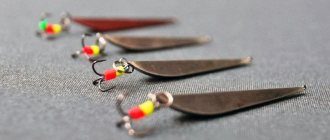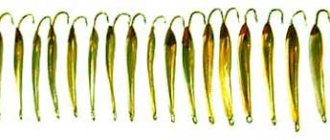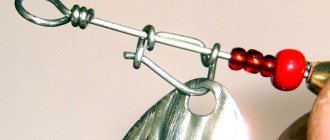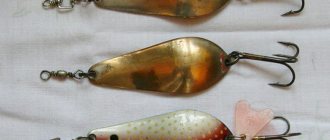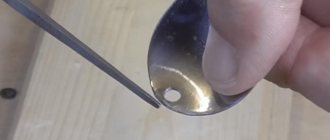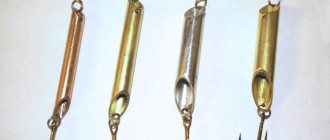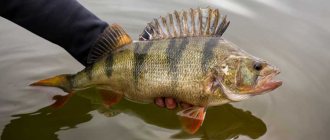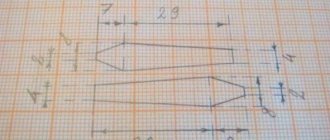| Place | Name | Characteristics in the rating |
| TOP 5 best julesins for asp |
| 1 | RB Devon Dragonfly 16 gr. Silvering | The best attraction for an asp. Eliminates line twisting at high fishing speeds |
| 2 | Halco Twisty 10g | Versatility and Durability |
| 3 | Renegade Iron Minnow 18g color FA156 | The heaviest "oscillator" |
| 4 | Mepps Aglia Long Heavy 2 | Confirmed catchability |
| 5 | Zhereh.ru “Krylatka” 15g | Best price. Effective bait for trophy asp |
Spinning fishing for asp requires special spinners that can attract a river predator. In the summer it stays closer to the surface (it drowns out the fry with blows of its tail), in the spring it prefers to be in the water column, so the bait and methods of placing it must take into account the peculiarities of the fish’s behavior.
This review presents the best lures for asp that you should take with you on a fishing trip. The rating includes the most popular baits, whose owners in most cases are completely satisfied with their catchability.
Homemade baits
The easiest homemade products to make are sometimes much more effective than store-bought ones.
DIY from a spoon
Instructions:
- The handle is sawed off.
- Holes with a diameter of 1.5 - 2.0 mm are drilled in the upper and lower parts.
- The swivel with the winding ring is inserted into the upper hole.
- A winding ring is inserted into the lower part for the tee and edge.
- The tee and edge are put on.
From a chrome tube in 20 minutes
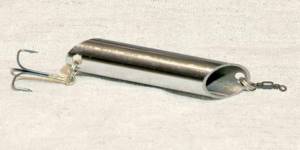
- On both sides of a tube of arbitrary length, arbitrary diameter, excess sections are sawed off at arbitrary angles.
- At the ends of the tube, closer to the edges, holes are drilled symmetrically on both sides for attaching the winding rings.
- A swivel is inserted into the winding rings on one side and a tee on the other.
Experiments with the choice of arbitrary values that affect the play of the spinner will allow you to select the most effective model.
Extra step.
A fishing line stretched obliquely inside a tube with a lead ball fixed in an arbitrary place will allow you to change the balancing of the spinner and produce noise effects due to the ball hitting the walls.
Catching asp with a spoon
The asp spinner is an artificial bait with a narrow body, which allows for quick retrieval and convenient casting.
In appearance, the bait is similar to bleak and small chub, which are preferred for feeding asp. This is a river fish. In summer, it spends more time at the surface, which is important to consider when choosing bait for stable performance. Closer to autumn, the predator moves to the middle horizon or sinks to the bottom. At this time, slow wiring with step play is performed.
Winterlures
Spinner “Return Tiu” - 42 mm. Single (soldered)
- Length a - 42 mm
- weight 1.9-2 g.
- Single-crown
- Material: brass as standard, we will make it to order from materials: cupronickel, beryl (bronze), brass, copper. Can be made from silver, by agreement.
- Equipment: soldering (single)
- Master : Tiunov Kirill Igorevich “K”
- Handmade winter lure
A drawing with the dimensions of this spinner was taken in one of the issues of the anthology “Angler-Sportsman”. In his article, the author gave the dimensions of the spoon and the technology for its manufacture.
Presented before you is the classic “Return” with a soldered single hook, copied exactly to the dimensions specified in the article. A wide body with a size of 42 mm means that the spoon will catch “gastronomic” perch. Cutting off the little things. “Lace” also loves her.
Designed for catching perch in shallow or deep water. When dropping the spinner, the “return” always lies on the horizon, hook up, and smoothly moves to the side, making oscillatory movements.
Often the perch stands close to the shore, along reeds or bushes where a regular spoon does not have enough room to swing. That’s when this “old” spinner comes in handy.
The game is a smooth high rise/sharp drop (we give the line to the lure) - after a jerk, in free fall, the “Return” swims some distance, more than 20-30 cm horizontally to the bottom. And the more line we give it, the longer and further the spinner goes. We recommend that you periodically place the spoon on the bottom and lightly tap (raising the cloudiness) then lightly and slowly pull the “Return” back, a pressure or a confident bite may immediately follow. Don’t be surprised if some of the perch are caught by the “tie”; the perch presses the lure to the bottom. He doesn’t want to eat, but he can’t let go of the “dying” fry.
A spinner with a single spinner (soldered in) gives advantages for:
+When fishing in snags and grass, there are much fewer hooks
+ makes it possible to play more sharply, eliminating overlaps.
+Higher fishing rate during “distribution”
+ Temperature, for those who fish in cold weather without taking off their mittens (gloves)
An interesting incident happened on one of the pay zones near Moscow, where one of my friends ran for half a day and caught trout, which did not bite on Williams and Ratlin. Having changed the usual Williams to the “Return” one, from the very first hole he caught the first trout weighing about 800 grams. The second trout didn’t take long to wait, its weight turned out to be under one and a half kilograms, once on the ice the trout broke off the hook of the spinner, but the opposite one is designed for catching perch and small pike. But still, during the period of inactive trout biting, on the pay zones of the Moscow region, “Return” can become a real panacea.
V. Solopov:
Spinner "Reverse" (Tiunovskaya)
We found a drawing with the dimensions of this spoon in one old, old fishing book. In his article, the author gave the dimensions of the spoon and the technology for its manufacture. In principle, there is nothing complicated, but with some modifications that we made to this bait, it turned out to be truly super versatile. When making the first “Return” several years ago, Kiril Tiunov and I could not even imagine that we would succeed. So what we initially got, of course, was a classic Return with a soldered-in single hook, exactly according to the dimensions indicated in the article.
Seeing the play of this spoon, I was amazed, but more on that a little later... Looking ahead a little, this bait is designed for large-scale search for predatory fish at depths of up to 3 and 7 meters, respectively (depending on the size of the spoon). The main object of the hunt is perch, but on almost every fishing trip, “Reverse” was attacked by pike or pike perch, which was a very pleasant bonus! Let's go in order...
Attitude...
Do you know at least one search lure that, after a jerk, in free fall, floats a certain distance, say 20-30 cm horizontally to the bottom. No? Now you know... The reverse one is a real search spoon, which, after a jerk, at a depth of 2.5 m, swims at least 20 cm horizontally on the surface while swaying from side to side. The distance from the hole at a depth of 2.5 meters is about 1.5 meters, which is simply amazing for a bait measuring 42 mm.
Purpose
There is poor visibility in the reservoir due to a large amount of snow on the ice or because of the peat bottom. Perhaps the water is cloudy in the platform due to the shallow depth and high density of fish. In such places, you need a bait with good attractive qualities, such as vibration, accuracy of movement, and visibility. The reverse – in this case it becomes simply irreplaceable. It is also possible to use this bait in clear water, in the case when you need to comb the largest possible area of the reservoir as quickly as possible.
Peculiarities
Reverse - after the jerk, it takes a horizontal position (lays with the hook up) and begins to move, first horizontally to the bottom, just below the depth to which it was thrown. Afterwards, the spoon moves at a slight downward angle while swaying from side to side, which causes itself to shine intensely, either with its brass or silver side. Such working qualities of the bait allow you to influence the predator hunting with the lateral line, and also give visibility due to flashes of metal.
Mode of application
The reverse was originally invented for catching perch in reservoirs with poor visibility, but as it turned out during the fishing, pike perch, bersh, pike, trout respond well to it in places where the depth does not exceed 4.5 - 5 meters. For Perch: As for catching perch, everything is the same here as with most other search lures. It is possible to catch with standard jerks, their amplitude is 5 – 30 centimeters, respectively, with pauses of different durations. It is possible to catch on extinction. The first jerk with an amplitude of 20 cm, pause. The second with an amplitude of 10 cm, pause. The third is very short, 1-3 cm, pause. Then we change the level, raising the spoon a little higher by 20 cm and again the same cycle. It is possible to comb different layers: jerk (different amplitudes are possible), pause. The next jerk to a higher level (10-15 cm), a pause, the next one even higher, and so on for a whole cycle from the ice to the level of the heel. In this case, you need to try to ensure that jerks, lifts and pauses are standardized. If the perch is active, then it is best to use the “Return” with a soldered single hook; if not, then with a suspended tee, or if it is completely inactive, then with a chain.
For pike and trout: The most effective retrieve in this case will be a rise with smooth acceleration (20 - 50 cm) and a release with a long pause. This cycle is done 5–10 times on one level. For Attraction, it is possible to perform 3-4 jerks in a row with minimal pauses of 1-3 seconds. For pike and trout fishing, the best way is to use a return line with a hanging tee.
For catching pike perch and bersh: There are days when these predators go to areas of the reservoir with a depth of 2.5 - 4.5 m. On such days, the reverse accumulation of this fish in a place will work wonders. At one level, 2-5 cm from the bottom, we make jerks (smooth acceleration) with an amplitude of 20-50 cm, after which we maintain long pauses of up to 50 seconds. At the moment of pause, the Reverse returns to the starting point, swaying from side to side. 7-10 jerks are enough for this. To determine the presence of pike perch under the hole. It is possible to move the bait on the bottom, which sometimes gives a striking effect. If the pike perch is active, then the Reverse one with a suspended tee is best suited; if you often have to touch the bottom, then it will be most convenient to use a spinner with a soldered single tee.
From practice... In North Karelia there is a wonderful lake called Kukos. This place is well known to local fishermen. Here you can catch decent char, burbot, whitefish, ide and of course pike. In the area of this lake there are several Lambins, the main inhabitants of which are pike and perch, both of quite impressive size. In these lambins, the color of the water resembles coffee that has not been diluted with milk. Visibility underwater is not very good, the day is short and, accordingly, it is necessary to find a concentration of predators as quickly as possible. With the help of the reverse, which makes fairly wide fluctuations and goes to the maximum possible distance from the hole, Sasha Dunaev and I manage to find several good perch points within an hour and catch more than a dozen decent perches from them. What is most striking is that the fish practically do not react to small VS - Magic, Tiu, or similar ones. This is primarily due to poor visibility, which in turn requires the bait to oscillate quite widely, as well as a large angle of deviation from the hole.
In the Moscow region , the reverse one is excellent for catching perch in lakes, quarries, as well as any other bodies of water with limited visibility, but as it turned out later, that’s not all. The water in the Ivankovo reservoir cannot be called dark, visibility is excellent, there are a lot of perch, their sizes vary. What’s going on, I’m running around the holes with VSh - Magic, I’m great at catching perch, but along with humpback whales I come across a huge amount of “bibiki” that needs to be unhooked, which in turn takes a lot of time. Having set the Reverse, I immediately cut off small perch and now striped ones from 150 grams and above are caught on my bait. I only catch 3-5 perches per hole, but pan perches. When the perch stops biting and if I want to catch a bibika, I lower a smaller spoon into the same hole and catch either few active or smaller stripers. In this case, the Inverse is not only the spoon that first of all catches large perch from under the ice, but also perfectly attracts small ones, which in turn gather around it in a large flock. In the Obratnaya reservoirs near Moscow, it showed excellent performance when fishing for coastal pike. Despite the perch hook, I have more than once managed to hook kilogram grass fish with it and leisurely drag them onto the ice.
An interesting incident happened on one of the pay zones near Moscow, where one of my friends ran for half a day and caught trout, which did not bite. Having changed the usual Williams to the “Return” one, from the very first hole he caught the first trout weighing about 800 grams. The second trout did not take long to wait, its weight turned out to be under one and a half kilograms, once on the ice the trout broke off the hook of the spinner, however, the reverse one is designed for catching perch and small pike, but still during the period of inactive trout biting, the “Return” can become a real panacea.
